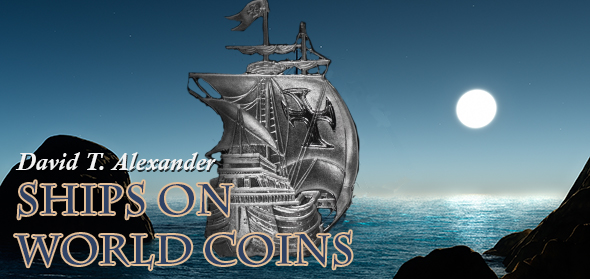
By David Thomason Alexander for CoinWeek …..
With their natural grace and implied motion, Ships are among the most beautiful elements in the coin designs for nations around the globe and provide a wonderful collecting topic for beginning and advanced collectors. The appeal of a graceful Bahamian sloop or a smooth-sailing Fiji outrigger canoe in overwhelming, especially on a dreary snow day in upper New York State or after a storm in Chicago.
An immense variety of ships appear on coins, with metals and denominations to fit every budget. For the purposes of this brief survey, circulating coins and commemoratives within the grasp of the average collector will be highlighted.
Great Britain has possibly been the greatest seafaring nation of history, but you might not know it from her coinage. The defensive role of her navy that formed “the wooden walls of old England” dates back to post-Roman times. Subsequent British dominion of the seas gave birth to her globe-spanning Empire and destroyed the hopes of a number of would-be world conquerors including Napoleon and Hitler.
But in the rich fabric of British coinage, ships initially appeared very sparingly, initially only as backgrounds for stylized royal portraits on gold coinage of the middle ages. Coins of the Tudor, Stuart and Hanoverian monarchs avoided ships and pictorial designs of any kind altogether, though a few coins bore oblique references to such major sea-connected victories as LIMA and VIGO.
The idea of placing an identifiable ship on circulating coinage surfaced in 1936 as the British Royal Mint (BRM) prepared new coin designs for King Edward VIII, the youthful and popular monarch who succeeded to the throne on the death of his father George V early in the year. Artist Humphrey Paget created several modern designs including a proposed 1937 halfcrown with a detailed view of Sir Francis Drake’s ship the Golden Hind.
With sails billowing in the wind and flags whipping from all three masts, this ship was lively and wholly pleasing, recalling Drake’s epic circumnavigation of the globe under the first Queen Elizabeth. In the event, however, it was not adopted for the silver half crown but was shifted to the 25.4mm bronze halfpenny.
As no circulating portrait coins were ready when the King abdicated and left England as the Duke of Windsor, the first new ship halfpence placed in circulation portrayed his younger brother, King George VI. The popular design was continued under Elizabeth II from 1953 through 1967 when the decimalization of British coinage eliminated the denomination.
The reign of Elizabeth II coincided with a massive proliferation of coinage of smaller island possessions such as the Isle of Man, located in the Irish Sea. Man began to release circulating decimal coins in 1971 including a 30mm, seven-sided cupronickel 50 new pence presenting the Arnold Machin bust of the queen and a carefully reconstructed Viking longship sailing toward the viewer.
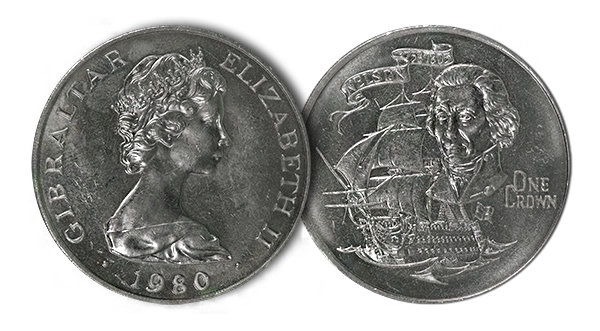 Manx coinage expanded geometrically into a flood which continues today, with many coins offering Viking themes. The tiny British enclave of Gibraltar soon followed its lead. Its burgeoning coinage issues include a 38.8mm copper-nickel 1980 crown whose reverse portrayed the naval hero of the Napoleonic Wars, Admiral Horatio Nelson, above a view of his flagship HMS Victory. Britain herself waited until 2005 to so honor Nelson and his flagship on the anniversary of the Battle of Trafalgar.
Manx coinage expanded geometrically into a flood which continues today, with many coins offering Viking themes. The tiny British enclave of Gibraltar soon followed its lead. Its burgeoning coinage issues include a 38.8mm copper-nickel 1980 crown whose reverse portrayed the naval hero of the Napoleonic Wars, Admiral Horatio Nelson, above a view of his flagship HMS Victory. Britain herself waited until 2005 to so honor Nelson and his flagship on the anniversary of the Battle of Trafalgar.
Further afield we find the island of Saint Helena in the South Atlantic, once a United British East India Company outpost made famous as the place of exile and death of the defeated Emperor Napoleon. Saint Helena inaugurated modern coinage with 38.6mm .925 silver and copper-nickel 25-pence coins dated 1973.
These depicted a towering East Indiaman under full sail, flying from her stern a flag that went unnoticed by most American collectors. It bore the British Union flag in the canton with 13 red and white stripes filling the field. This was the East India Company flag that was carried by Patriot forces at the Battle of Bunker Hill and there called the “Grand Union Flag.” It was not American but the flag of the Company whose property was thrown into Boston Harbor in the famous “Boston Tea Party!”
Ships of the ancient Mediterranean world have graced coins of Cyprus and Greece. Cyprus’ first 1955 decimal 28mm copper-nickel 100 mils presented a graceful galley sailing right over-stylized waves with swan’s head stern and single sail. Ancient epic poet Homer was portrayed on the Greek Republic’s aluminum-bronze 50 drachmas of 1986, whose reverse bore a beautifully detailed galley sailing left “o’er the wine-dark sea” under a billowing single sail.
Located in the Near East, Lebanon has repeatedly celebrated its ancient Phoenician heritage with views of galleys recalling those great seafarers who some historians believe may have reached Britain or even South Africa. Aluminum-bronze two and five piastres struck at Paris in 1925 and several denominations from 1952 to 1961 that also present views of galleys recalling this small country’s proud maritime record.
The island nation of Malta, long a British possession, was ruled for centuries by the Sovereign Military Order of St. John of Jerusalem (SMOM), an order of crusading knights which still exists with headquarters in the Bocca de Leone in Rome.
 Ousted from Malta by Napoleon in 1798, the knights ultimately relocated in Rome and now enjoy diplomatic relations with some 30 nations and extraterritoriality like that of the Vatican. Grand master Fra Angelo de Mojana resumed coinage in the late 1960’s. Though not a circulating coin in the ordinary sense, the 40mm silver 1978 2 scudi is too fascinating to omit.
Ousted from Malta by Napoleon in 1798, the knights ultimately relocated in Rome and now enjoy diplomatic relations with some 30 nations and extraterritoriality like that of the Vatican. Grand master Fra Angelo de Mojana resumed coinage in the late 1960’s. Though not a circulating coin in the ordinary sense, the 40mm silver 1978 2 scudi is too fascinating to omit.
Its reverse presents a SMOM war galley of the 1600s, propelled by 30 oars and a single sail, a vessel suggests a water spider with many legs. Such ships brought many a victory in the Order’s wars with the Ottoman Turks.
One of Europe’s greatest seafaring nations is the Netherlands, which emerged as the seven United Provinces in the independence war with Spain. Dutch sea power grew in the 1600s to rival that of Britain, but surprisingly few maritime themes appear in the rich coinage tapestry of this tiny nation.
Dutch naval might established a vast empire in the East Indies, today’s Indonesia. During the Napoleonic era, the Batavian Republic struck five denominations of .916 silver coins called Scheepgulden, from the diminutive 1/16 to one gulden. Shown here is the 27.3mm half gulden.
 Each bore the republic’s Arms and a three-masted Dutch East India Company ship sailing right with legend INDIAE BATAVORUM. These are all scarce today, and South African collectors long sought the coins on the theory that some may have been circulated at Capetown near the end of Dutch rule.
Each bore the republic’s Arms and a three-masted Dutch East India Company ship sailing right with legend INDIAE BATAVORUM. These are all scarce today, and South African collectors long sought the coins on the theory that some may have been circulated at Capetown near the end of Dutch rule.
Another Dutch ship coin appeared under far darker circumstances, the 26mm zinc 25 cents of 1941-1943, struck for the German occupation government of Minister President Anton Mussert. These were handsome coins despite their metal, presenting a Viking longship powerfully breasting robustly stylized waves above the national name NEDERLAND.
Germany has a vast coinage history spanning the centuries but remarkably few coins have been devoted to ships. Under the Weimar Republic of 1918-1933, an exceptionally handsome series of .500 silver commemoratives appeared in three- and five-reichsmark denominations, including 1927 coins hailing the centenary of the port of Bremerhaven.
Struck in Berlin from designs by Maximilian Dasio were 30mm three- and 37mm five-reichsmark pieces bearing a spirited three-masted schooner flying the flag of Free and Hanseatic City of Bremen. Bremerhaven was a man-made port created by dredging the nearly completely silted mouth of the River Weser in the territory of the Kingdom of Hannover.
By treaty, the new port was attached to Bremen, later a constituent state of the German Empire. The Hansa referred to in the city name was a great trading association of medieval ports in the Baltic and North Seas. Both Bremen and booming Hamburg remain states of today’s Federal Republic. The everlastingly popular Weimar commemoratives, including the Bremerhaven, have seen wild price swings over the decades on the numismatic marketplace.
Between the wars, the League of Nations tried to provide Baltic Sea access to both reborn Poland and defeated Germany by declaring the key port of Danzig a free city accessible to both countries. Danzig had its own coinage, based on the gulden of 100 pfennig.
 Scarce today, Danzig coinage boasted several medieval ship designs befitting its maritime history. In 1923 came a .750 silver, 20mm half gulden designed by Otto Fischer with a stylized two-masted cog riding high over three bold waves, struck at Utrecht.
Scarce today, Danzig coinage boasted several medieval ship designs befitting its maritime history. In 1923 came a .750 silver, 20mm half gulden designed by Otto Fischer with a stylized two-masted cog riding high over three bold waves, struck at Utrecht.
Erich Volmar designed the 29mm pure nickel 1935 five gulden with another stylized cog sporting a single mast with sail furled on a choppy sea. This nickel coinage is now of significant rarity as most coins were withdrawn and melted after the 1939 Nazi takeover.
Austria has been a landlocked nation for nearly a century and it is often forgotten that in 1914 the Habsburg Empire had the seventh-largest naval fleet in the world. A key figure in the early planning of that fleet was the Archduke Ferdinand Maximilian, brother of long-lived Emperor Franz Josef.
Formerly Viceroy of Austrian possessions in Northern Italy, Maximilian accepted the offer of a Mexican throne in 1864. He tried to introduce an orderly and progressive monarchy but was only able to rule with French military support. When the Americans demanded withdrawal of Napoleon III’s forces, Maximilian refused to abdicate, was besieged at Querétaro and shot by the republican forces of Benito Juarez.
Maximilian was portrayed of a .900 silver, 34mm 100 schilling in the Vienna Mint series “Tragedies in the House of Habsburg.” The obverse bears his tall, fork-bearded standing figure in Mexican court attire with the Orders of the Golden Fleece and the Mexican Eagle. The reverse offers a view of the Adriatic coast palace of Miramar with departing warship SMS Novara, which also bore the emperor’s body back to Europe.
 Modern Italy achieved essential unity in 1861 under the House of Savoy. Coming late to the arena of European powers, Italy (somewhat like united Germany), pursued ambitions that her actual power and wealth could not always satisfy. Among these was building a significant navy and colonial empire.
Modern Italy achieved essential unity in 1861 under the House of Savoy. Coming late to the arena of European powers, Italy (somewhat like united Germany), pursued ambitions that her actual power and wealth could not always satisfy. Among these was building a significant navy and colonial empire.
Naval themes dominated the bronze 10-centesimi, silver five-lire, and gold 50-lire coins commemorating the 50th anniversary of unification celebrated in 1911. Designed by Domenico Trentacoste of the Rome Mint, the 30.1mm 10 centesimi portrayed numismatist-king Vittorio Emanuele III. The reverse bears an allegory of helmeted Rome greeting modern Italy before a wooden-hulled warship.
The republic which took power in 1946 had a slow start in coinage but by 1958 had managed to supply most of the nation’s needs. Among the coins adopted was one of Europe’s most beautiful postwar coins, the 29.3mm, .835 fine silver 500 lire designed by Pietro Giampaoli and Guido Veroi.
The obverse personifies Italia as a tall, elegant matron in rich Renaissance garb surrounded by a circle of tiny city shields, modeled by Giampaoli’s beautiful wife. The reverse presented the three ships of Christopher Columbus (Cristoforo Colombo), the Genoa-born discoverer of the New World.
 The Spanish-speaking world finds Italian celebration of Columbus curious as the navigator sailed in Spanish ships under the patronage of Spanish king and queen. He never wrote a line in Italian and his discoveries doomed the great trading empires of Genoa and Venice to stagnation and effective death.
The Spanish-speaking world finds Italian celebration of Columbus curious as the navigator sailed in Spanish ships under the patronage of Spanish king and queen. He never wrote a line in Italian and his discoveries doomed the great trading empires of Genoa and Venice to stagnation and effective death.
Ships appear often in religious art, notably the Barque of Peter in Catholic imagery. The first coinage of the State of Vatican City created by the 1929 Lateran Treaties between the Italian government and Pope Pius XI included a 23mm .850 silver five lire designed by Aurelio Mistruzzi.
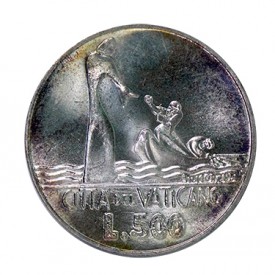 Its reverse shows St. Peter struggling to control his open barque on the wave-tossed Sea of Galilee. This design was continued in the first coinage of Pius XII in 1939-1941. The last coin set of Paul VI included a 29.3mm, .835 silver 500 lire struck in 1978 with designs by Nicola Morelli. This coin shows Jesus extending his hand to James and John whose unsuccessful night’s fishing has just ended in a miraculous catch that threatens to swamp their suddenly over-filled boat.
Its reverse shows St. Peter struggling to control his open barque on the wave-tossed Sea of Galilee. This design was continued in the first coinage of Pius XII in 1939-1941. The last coin set of Paul VI included a 29.3mm, .835 silver 500 lire struck in 1978 with designs by Nicola Morelli. This coin shows Jesus extending his hand to James and John whose unsuccessful night’s fishing has just ended in a miraculous catch that threatens to swamp their suddenly over-filled boat.
The Iberian nations of Portugal and Spain were among the most important seafaring countries of history, and their achievements overlapped in time. Portugal is small in territory, but few maritime nations can match her roster of historic discoveries. From the 1400s onward, this small nation facing the wide Atlantic was a world leader in exploration and discovery in Africa, Asia, and South America.
Directing decades of exploration from his seaside castle was a son of King João I, Prince Henry the Navigator, (Infante Dom Henrique, 1394-1460). Not an active explorer himself, Henry trained and sent forth waves of captains further and further down the African coast, rounding the Cape of Good Hope and across the Indian Ocean to the west coast of India.
So intent were the Portuguese on finding a route to India by sailing around Africa, that they rebuffed Columbus when he appealed to King João II for aid to facilitate his proposed western voyage. The Portuguese and Spanish discoveries took place in the same time frame and to preserve peace, Pope Alexander VI (of the Spanish branch of the Borja family) decreed the Line of Demarcation on May 4, 1493.
Drawn on still-primitive maps, this line divided the New World 100 leagues west of Cabo Verde and Madeira between Spain and Portugal. On June 4, 1494, the Treaty of Tordesillas moved the line 270 leagues farther west, assigning the eastern tip of South America to Portugal.
On April 21 1500, Dom Pedro Alvares Cabral reached and claimed Brazil, while the extended voyage of Amerigo Vespucci for Portugal in May 1501-Sept. 1502, finally determined that the new lands were not parts of Asia but were indeed new continents. To them the German mapmaker Martin Waldseemüller assigned the name America.
Portugal waited until the 20th century to begin issuing ship coins, though the Quadricentennial of the Portuguese arrival in India was hailed by three handsome silver coins in 1898. These portrayed King Carlos, Queen Amelia and the cross of the Order of Christ rather than a ship.
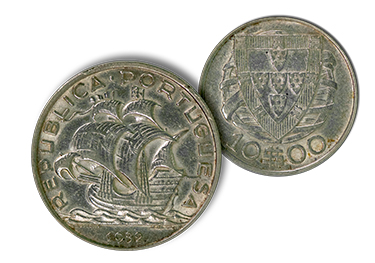 Three first ships graced circulating Portuguese coins in 1932: 30mm .835 silver 10 escudos; 28.4mm .650 silver five escudos and 20.41 2.5 escudos. All presented a short-hulled, high-decked sailing caravel with towering masts sailing left with the National Arms over an armillary sphere on the reverse. In 1963 these yielded to copper-nickel coins bearing a small, rakish two-masted sailing vessel called a não.
Three first ships graced circulating Portuguese coins in 1932: 30mm .835 silver 10 escudos; 28.4mm .650 silver five escudos and 20.41 2.5 escudos. All presented a short-hulled, high-decked sailing caravel with towering masts sailing left with the National Arms over an armillary sphere on the reverse. In 1963 these yielded to copper-nickel coins bearing a small, rakish two-masted sailing vessel called a não.
From 1985 onward, Portugal released an extensive series of copper-nickel and silver commemoratives with added special editions in gold, platinum, and palladium hailing anniversaries on seafaring events. Included with rare irony were 200 escudos dedicated to COLOMBO E PORTUGAL recalling the abortive interactions with Columbus in 1476-1485.
A swelling flood of additional maritime commemoratives honored discoveries and discoverers including Prince Henry, now suddenly identified as Henrique o Navegador; voyages around Africa, across the ocean to India, the East Indies, and on to Portugal’s largely forgotten intercourse with Japan.
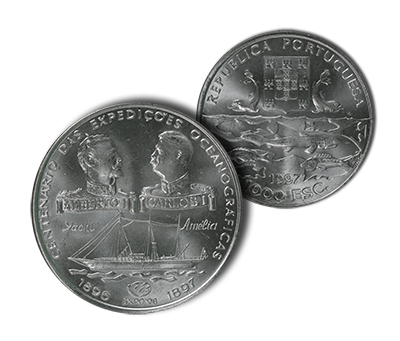 Among these innumerable historic topics was one more modern ship subject honored on the .500 silver, 40mm 1,000 escudos of 1997. This handsome coin honored the oceanographic researches and expeditions of two monarchs: Portugal’s King Carlos I (1848-1908) and Monaco’s Prince Albert I of Monaco (1848-1922).
Among these innumerable historic topics was one more modern ship subject honored on the .500 silver, 40mm 1,000 escudos of 1997. This handsome coin honored the oceanographic researches and expeditions of two monarchs: Portugal’s King Carlos I (1848-1908) and Monaco’s Prince Albert I of Monaco (1848-1922).
Their facing busts were placed above the Portuguese research yacht Amelia, named for Carlos’ queen, born Princess of Orléans. This coin was released in connection with the international maritime Expo ’98.
Spain’s achievements on the seas were even more extensive than those of Portugal but inexplicably, Spanish coinage presents virtually no ship subjects over six centuries. Virtually all collectors associate Spanish doubloons (gold coins of eight escudos and their divisions) and pieces of eight (silver eight reales) with sea adventure, pirate lore, sunken treasure, but none of the hundreds of denominations, dates, and types depict ships of any kind.
The one beautiful exception was the copper-nickel 25 Céntimos struck in 1926 under Alfonso XIII. This 25mm coin presents a vivid view of a storm-tossed Santa Maria, the flagship of his tiny fleet that we know Columbus’ so disliked. Bearing westward in heavy seas with flags whipping, this coin shows how bold design brings beauty even to base metal minor coins. This one-year issue with 8 million struck is scarce today and hard to find in true Mint State.
Until 1989, Spain rigorously avoided issuing commemorative coins of any kind. It was simply not done until the reign of Juan Carlos I when the dam broke and it seemed that Spain was trying to make up for centuries of lost opportunity.
Gold and silver pieces bearing denominations from 100 to 80,000 pesetas were issued, and following the adoption of the euro, coins of five to 400 euros followed, but most of these were well beyond the reach of collectors of average means.
As we have seen, these early explorers worked freely for sponsoring monarchs without regard to nationality. Columbus was a Genoese working for the monarchs of Spain; Vasco da Gama was a Spaniard sailing for the king of Portugal. Among the most important yet least known mariners was John Cabot, born in Genoa as Giovanni Caboto around 1450, who emigrated to and became a citizen of Venice in 1476 as both great trading cities were about to be overtaken by the great discoveries across the Atlantic.
Moving to England around 1488, to escape imprisonment for debt, Cabot planned to find a shorter westward path than Columbus via the North Atlantic, sailing in the 50-ton Mathew with an 18-man crew with support of the parsimonious King Henry VII. Setting out from Bristol in May 1497, the Mathew reached North America on June 24, probably on the coast of Newfoundland but conceivably Labrador, Cape Breton Island, Nova Scotia or even Maine
Cabot’s next voyage started with five ships and 360 men but its outcome is shrouded in mystery. Some historians believe he was lost at sea; alternatively, he returned by 1500; take your pick. In any event, Cabot claimed the land he discovered for England, bypassing the limitations of Tordesillas and assuring the emergence of English-speaking colonies of North America.
Numismatic reminders of the Cabot voyages are surprisingly few. Canada issued an especially handsome 36mm, .800 silver 1949 silver dollar depicting the Mathew to hail the entry of Newfoundland into Canada as that dominion’s tenth province.
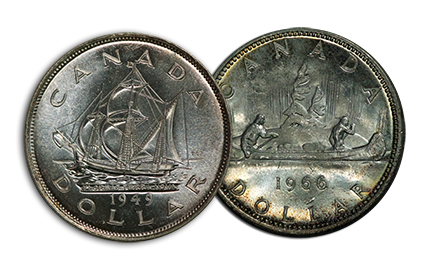 Comparatively little numismatic note has been taken of pre-European ships in the New World. Canada has excelled in this field, notably with Emmanuel Hahn’s famous Voyageur silver dollars with their Hudson’s Bay Company birch bark canoes that graced Canada’s silver dollars of 1935-1972.
Comparatively little numismatic note has been taken of pre-European ships in the New World. Canada has excelled in this field, notably with Emmanuel Hahn’s famous Voyageur silver dollars with their Hudson’s Bay Company birch bark canoes that graced Canada’s silver dollars of 1935-1972.
Hahn’s skill is also seen in the Canadian 10-cent pieces struck since 1937 that depict the lovely Nova Scotia schooner Bluenose sailing left. Found as an abandoned hulk in the West Indies, this elegant vessel was lovingly restored as a monument to Canada’s sea-going heritage.
Highly impressive is the 1989 .500 silver dollar recalling the explorations westward by Scots explorer Sir Alexander Mackenzie (1764-1820). The reverse displays a large birch bark canoe vigorously paddled by a seven-man crew up the Mackenzie River between rocky banks and pine forest.
Northern Europe figured in two waves of sea exploration, the Viking era and the 1600’s. In 1938, Sweden joined the U.S. in celebrating the 300th anniversary of New Sweden-Delaware. Erik Lindberg designed a 31mm, .800 silver two kronor showing the ship Kalmar Nyckel nearing Fort Christina; the U.S. Mint struck a .900 silver half dollar by Carl L. Schmitz bearing the same ship and a view of Old Swedes Church near Wilmington.
The 1938 two kronor received much off-hand publicity in the U.S. from American coin dealers who were then generally abysmally ignorant of the larger world. Most collectors today know that Sweden followed up for Delaware’s 1988 350th anniversary in 1988 with two commemoratives: the .925 silver, 32mm 100 kronor, and .900 gold, 21mm 1,000 kronor for this same historical event.
Neighboring Norway celebrated the 150th anniversary of organized emigration to the U.S. with a 29.5mm copper-nickel five kroner of 1975 bearing the brig Restaurasjonen, The centennial of the same event had been hailed by the octagonal silver 1925 Norse-American Medal, an oddly named Viking-theme design that confused generations of American collectors ever since.
 Finland is one of the only countries to honor working ships on its coinage, the powerful icebreakers whose endless labor keeps open the Gulfs of Finland and Bothnia during the iron northern winters. Aluminum-bronze 26.3mm five markkaa first issued in 1972 and 1979 depict powerful vessels sailing right or left, surrounded by massive chunks of shattered ice.
Finland is one of the only countries to honor working ships on its coinage, the powerful icebreakers whose endless labor keeps open the Gulfs of Finland and Bothnia during the iron northern winters. Aluminum-bronze 26.3mm five markkaa first issued in 1972 and 1979 depict powerful vessels sailing right or left, surrounded by massive chunks of shattered ice.
Poland has a seafaring tradition personified by her long-lived naval training ship Dar Pomorza. Bearing three masts and several added bowsprit sails, this exceptionally graceful ship sails left on .750 silver two- and five-zlotych coins of 1936. Surviving World War II, the Nazi and Russian occupations, she celebrated her 50th anniversary on 29mm copper-nickel 20 zlotych in 1980.
Russia’s naval tradition was literally launched by modernizing Emperor Peter I, the Great, whose search for “Windows on the West” opened the Baltic to Russian ships and continues today with President Vladimir Putin’s seizure of Crimea.
A powerfully designed six-coin set dated 1996 marked the Third Centenary of the Russian Fleet. Sold by the Bank of Russia with a bronze medalet of Peter the Great, the coins were struck at Sankt Petersburg Monetii Dvor, the St. Petersburg Mint in a colorful card and sleeve. All coins bore an uncrowned, drop-wing double eagle first used by the vanished Provisional Government of Alexander Kerensky in 1917-21.
Denominations and metals included copper-nickel 100 rubles with Icebreaker Arctic; aluminum-bronze 50 rubles, submarine; 20 rubles, research vessel; 10 rubles, containerized freight; aluminum-bronze five rubles, 34-master ship; brass one ruble, trawler.
As we have already noted, ship coins in the New World have been many. Most historians agree that Columbus first landed on a Bahamian island that the Arawak Indians called Guanahani, which he named San Salvador, Holy Savior.
Under British rule it was called Watling’s Island and the Columbus role was downplayed. The first colonial copper pennies dated 1806 showed a small head of King George III and a seal bearing a British sailing ship and motto EXPULSIS PIRATIS/RESTITUTA/COMMERCIA, Pirates Expelled, Commerce Restored, that recalled Governor Woods Rogers’ ending of piracy.
The Santa Maria appears on many western hemisphere coins, including Bahamas coins since self-government was achieved. The Dominican Republic long claimed the Navigator’s tomb in the cathedral of Santo Domingo and has issued many Columbus coins. One is the 40mm copper-nickel one peso dated 1988, showing the Santa Maria, Niña and Pinta sailing within a legend noting the Fifth Centenary of the Discovery and Evangelization of America.
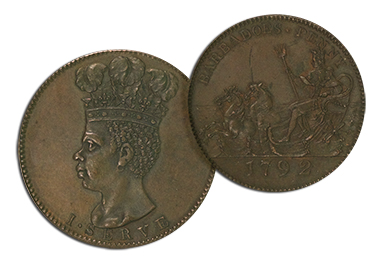 Bermuda’s first modern coin was the wildly popular .925 silver 38mm crown of 1959 showing a relief map bracketed by sailing ships Deliverance and Patience. Another old-line British colony was Barbados, which in 1793 saw striking of copper tokens bearing the head of an African figure wearing the Prince of Wales’ coronet and plumes and the English translation of the medieval motto “Ich Dien”, or “I Serve”.
Bermuda’s first modern coin was the wildly popular .925 silver 38mm crown of 1959 showing a relief map bracketed by sailing ships Deliverance and Patience. Another old-line British colony was Barbados, which in 1793 saw striking of copper tokens bearing the head of an African figure wearing the Prince of Wales’ coronet and plumes and the English translation of the medieval motto “Ich Dien”, or “I Serve”.
One reverse of these pennies, issued by influential planter Sir Philip Gibbs, depicts King George III seated in what older catalogers called “Neptune’s Marine Car,” drawn by mythological seahorses, ships of a fanciful kind.
There were satirical, anti-slavery overtones to these designs that are not fully understood today.
Ships graced many coins of the Danish West Indies (DWI), today’s U.S. Virgin Islands, since the 1700s, whether ocean-going sailing vessels or lighter-draft inter-island ships like the ship on the 25.7mm, .650 silver 1878 20 cents of King Christian IX. DWI was one of the few colonies that tried to supply adequate circulating coinage down to their annexation to the U.S. in 1917.
Recalling Brazil’s historic descent from Portugal and her dauntless navigators were coins struck in 1900 for the Fourth Centenary of Discovery by Dom Pedro Alvares Cabral. The 37mm, .917 silver 2,000 reis for this anniversary depicts a very low relief caravel at sea under the Southern Cross approaching the shores of what was to become the largest nation in South America.
One of the earliest ironclad warships was built by Laird’s in England in 1864 for Peru, christened Huáscar. Restored and still afloat today and regarded as a national treasure of both Chile and Peru. The only surviving steel vessel of that era, she fought at different times for the navies of rivals Peru and Chile and is forever identified with Peruvian naval hero Admiral Miguel Grau and Chilean Admiral Arturo Pratt, both of whom died aboard this historic ship.
 Her Peruvian role is honored by a .925 silver, 39mm 5,000 soles coin that recalls her heroic role in the Battle of Iquique in the War of the Pacific. Huáscar is today a memorial ship to honoring the fallen sailors of two former enemies in one of Latin America’s last shooting wars.
Her Peruvian role is honored by a .925 silver, 39mm 5,000 soles coin that recalls her heroic role in the Battle of Iquique in the War of the Pacific. Huáscar is today a memorial ship to honoring the fallen sailors of two former enemies in one of Latin America’s last shooting wars.
Few ancient ships of the Mediterranean world have attracted as much collector attention as the Hasmonean galley depicted on Israel’s 34mm, .900mm silver five lirot of 5723-1963 honoring the Jewish nation’s tradition of seafaring. The Rome, Italy, Mint produced 5,960 business strikes and 4,995 of this issue for the Independence Day series several years before that vast increase in the popularity of Israel coins.
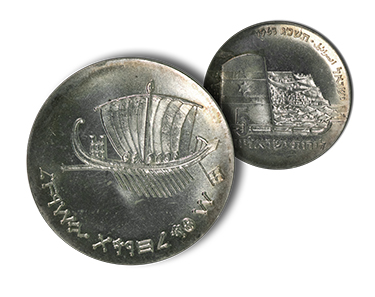 Designed by Zvi Narkiss and Izar Behar, the deeply basined (concave) obverse presents a view of Mount Carmel and Haifa from the deck of a modern Israeli steamship. The ancient galley on the reverse is taken from a Hasmonean tomb excavated at Rehavia near Jerusalem.
Designed by Zvi Narkiss and Izar Behar, the deeply basined (concave) obverse presents a view of Mount Carmel and Haifa from the deck of a modern Israeli steamship. The ancient galley on the reverse is taken from a Hasmonean tomb excavated at Rehavia near Jerusalem.
This coin was the classic rarity and market phenomenon of modern Israel coinage, released at $5.50 in Uncirculated, $7.50 in Proof. As the Israel market overheated after the June 1967 Six-Day War, Proofs climbed to more than $600 and showed no signs of slowing down. Founding of the American Israel Numismatic Association (AINA) increased the pace of the market and for several years it appeared that there was no limit on future growth.
As the post-victory fever subsided, the Israel Government Coins and Medals Corp. (IGCMC) unwisely continued to expand its offerings and both the David Ben-Gurion and Israel Bonds coins encountered serious sales resistance followed by an increasingly swift subsidence of the whole Israel market, which has never recovered to boom-time levels.
Egypt has issued ship coins in relation to her seizure, loss, and reopening of the Suez Canal. Among the most striking is the 35.5mm, .720 silver one pound dated 1401-1981 with its dramatically stylized national map with the canal highlighted behind three immensely tall, attenuated ships about to ply the newly cleared waterway.
Reminding Americans of recent wars is the 26mm copper-nickel 100 fils struck in 1961 for the newly independent Amirate of Kuwait, presenting a rakish lateen-rigged dhow sailing left. Typical coasting ship of the Persian (or Arabian) Gulf and the Indian Ocean, the dhow was built for generations by Kuwaiti craftsmen before oil production made the country rich. Forcibly annexed by Iraq in 1990, Kuwaitis watched the burning by Iraqi vandals of the Great Dhow, constructed as a memorial to a vanished craft.
Iraq was a kingdom ruled by the Hashemite dynasty until the 1958 revolution, formed from the ruins of the Ottoman Empire by the British in 1921. Some commemorative coins appeared under the Ba’ath party dictatorship of Saddam Hussein. Bearing an impressive view of a modern oil super-tanker was the 40mm, .500 silver dinar commemorating the nationalization of Iraqi oil.
 The larger Far Eastern nations offer few ships on their circulating coins. The Republic of China established in 1911 by Dr. Sun Yat-sen (Sun Wen) spent decades attempting to extend its authority over the whole country in spite of opposition from regional warlords, communist insurrections and finally the invasion of Manchuria and coastal provinces by an expanding Japan.
The larger Far Eastern nations offer few ships on their circulating coins. The Republic of China established in 1911 by Dr. Sun Yat-sen (Sun Wen) spent decades attempting to extend its authority over the whole country in spite of opposition from regional warlords, communist insurrections and finally the invasion of Manchuria and coastal provinces by an expanding Japan.
The Republic had achieved much success by the early 1930s under the presidency of Generalissimo Chiang Kai-shek. The paper currency was stabilized and new circulating 39.5mm, .900 silver dollars were struck bearing a portrait bust of Dr. Sun after an international design competition.
The reverse displayed a handsome two-masted junk sailing right with a brilliant sunrise at right, three wild geese flying overhead, flanked by the denomination I – Yuan. One Dollar. These boldly designed coins were dated Year 21 of the Republic, 1932. This year Japan’s Kwantung Army finalized the conquest of Manchuria, setting up the State of Manchukuo with the last Manchu (Great Ch’ing) Emperor P’u Yi as chief executive.
The dollar design was now interpreted as the Japanese Rising Sun; the geese as three bombing planes. Dollars dated Years 33 and 34 appeared without either geese or sun, resulting in a vastly less lively composition.
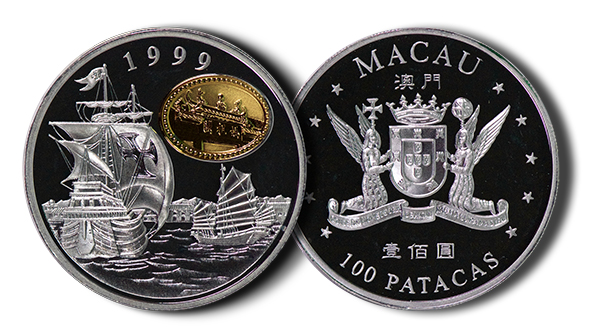
A wonderful contrast in European and Chinese ships characterized the .925 silver, 38mm 100 patacas of the Portuguese treaty port of Macau dated 1999, year of the port’s return to the People’s Republic of China. The Portuguese Arms supported by kneeling angels graced the obverse; the reverse bore a caravel and sailing junk side by side.
Modern Korea takes great pride in its 16th-century naval history. A powerful Japanese invasion under Toyotomi Hideyoshi in 1592 was initially a great success, leading to the royal court’s flight from Seoul. The over-confident Japanese navy was then repelled by Korean ironclad “turtle ships” built to the order of Korean Admiral Yi Sun-sin. Displaying junk-like sails, a dragon prow and banks or oars, the turtle boats appear today on bronze and brass five won struck since 1966 and NCLT .925 gold 50,000 won hailing the 1988 Seoul Olympics.
 Ships have been a popular motif of coins of major nations born as a result European settlement, including South Africa, settled in 1652 by the Dutch East India Company under Jan van Riebeeck. The first 1923 Union coinage included a 30.8mm bronze one penny, which continued to be struck with varieties in the denomination until decimalization in 1960. The penny featured a view of van Riebeeck’s Dutch East India Company ship Dromedaris proceeding under full sail toward the right.
Ships have been a popular motif of coins of major nations born as a result European settlement, including South Africa, settled in 1652 by the Dutch East India Company under Jan van Riebeeck. The first 1923 Union coinage included a 30.8mm bronze one penny, which continued to be struck with varieties in the denomination until decimalization in 1960. The penny featured a view of van Riebeeck’s Dutch East India Company ship Dromedaris proceeding under full sail toward the right.
Australia has released several coins dedicated to early explorers including Captain James Cook and their voyages as well as to Olympic boating events, including the .925 silver 10 dollars for the Bicentennial of Gov. Philip’s Port Jackson Landing Bicentenary depicting a sailing ship and the British governor heading for shore in a longboat.
 New Zealand coinage is rich in coins memorializing Captain James Cook and his discoveries from his ship HMS Endeavour, including a circulating bimetallic 50 cents struck in copper-nickel and nickel-brass with the ship coasting past distant Aorangi, Mount Cook. Cook is also portrayed on the U.S. Hawaiian half dollar of 1927 designed by Chester L. Beach but without a ship.
New Zealand coinage is rich in coins memorializing Captain James Cook and his discoveries from his ship HMS Endeavour, including a circulating bimetallic 50 cents struck in copper-nickel and nickel-brass with the ship coasting past distant Aorangi, Mount Cook. Cook is also portrayed on the U.S. Hawaiian half dollar of 1927 designed by Chester L. Beach but without a ship.
The Pacific islands coinages have featured European vessels including Cook’s and the Dutch sailing ship of Jacob Roggeveen that reached Samoa in June 1772 and appears on her copper-nickel commemorative tala with a tiny map of the islands.
The outrigger canoe is among the most beautiful of all sailing craft and appears of many Pacific island coinages, notably Fiji starting with her 23.5mm .500 silver shilling of King George V in 1934, a scarce coin today. A sharper view appears on the 31.5mm copper-nickel 12-sided 50 cents of 1986 with a three-man crew under full sail to the left. Outriggers appear as secondary design elements on coins of French Oceania, Polynesia and New Caledonia.
Whether they sail tropical seas, arctic wastes, raging rivers, or freshwater lakes, ships on coins offer irresistible appeal for collectors whose waking lives may be far more mundane and uneventful. This is, of course, one of the ancient lures offered by coins around the world.





There’s a faded small ship on the 1998 penny no mint mark right above the word Liberty and a faded date below 1998 that appears to be 1983, any info on this penny